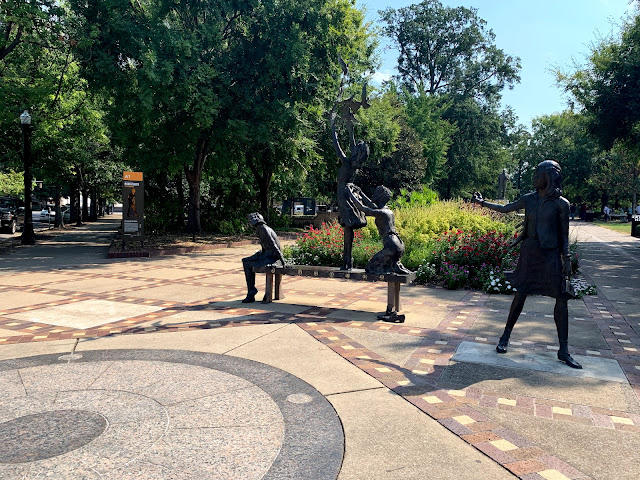It was hard to decide that we wouldn't visit Selma. Each person we met in Montgomery gave us the same advice: go to Selma, walk across the bridge. But some of these experiences don't seem appropriate for the children, no matter how important they are. It has been in the high nineties consistently during our time here and we couldn't see how the kids would make it over the bridge and still have the capacity to comprehend what had happened and what it meant.
(Apologies,:if you don't know this history, please look up the Pettus Bridge.)
This is the constant debate with this in-person educational experience: confronting the history, in person and on site is more meaningful than reading about it in textbooks. This visit has caused me to consider how to encourage other families (or classes, or schools) to make this journey. But these experiences, these confrontations and emotional or intellectual conflicts, are difficult. I believe we (and by we I mean white Americans even more than Americans as a whole) have an obligation to face those issues head on.
But it's also clear that the children experience burnout and the amount of information and knowledge that they actually receive declines, hour by hour and day by day. And so, arriving in Birmingham, we have to decide what to see and what to do. We read and heard repeatedly that this city became known as Bombingham during the fifties and sixties. As a follow-on to the focus on lynchings while we were in Montgomery, it was hard to bring the kids' attention to bombings.
The Birmingham Civil Rights Museum is excellent and it carefully covers a broad history. It has exhibits that connect effectively with children. Most of all, there are side by side classrooms from 1953 (as I recall) illustrating a number of differences. Our kids could relate to this and recognize the injustice of it. The museum carefully represents the role of children and young adults in Birmingham's civil rights movement, a point that I had missed in the focus on King's "Letter from the BIrmingham Jail."
Indeed, I learned in Birmingham that I've missed a lot by focusing so much on King as a figurehead of the movement. Here, Reverend Fred Shuttleworth comes to the fore as well as the children (as a group) and the DJ's whose coded messages coordinated the activities of the young people.
The experience we skipped, though, was the memorial inside the 16th Avenue Baptist Church where the most infamous bomb killed four girls. It is clearly a matter of privilege to select which difficult life lessons we present to our children. The parents of those girls didn't get to decide whether it would be their children to die in the struggle. You can tell that I remain uncomfortable with this decision but we realized, day by day, that it wasn't going to make the experience more enriching, particularly for the kids, to push them past that tipping point.
On the other hand, after we had "quit" our tour and set up for lunch in the RV, I found a barber shop and brought Lily with me for my latest shave. The next hour was extraordinary. My barber was a foot solider in the civil rights movement. He shared some stories while I sat in the chair but then he took us next door to the headquarters of the Civil Rights Activist Committee. (If you go to Birmingham, I strongly encourage you to seek out this organization to provide a guide for your tour!)
I have never heard somebody tell first person stories about the civil rights movement in this way. Several times he mentioned, "they shot my best friend right there that day." To whatever extent these events and these places were still an abstraction to me, James' stories made them much more real and personal.
We're glad we went to Montgomery first, by the way. The Legacy Museum and National Memorial for Peace and Justice are unparalleled. We feel it was best that the kids absorbed the information there first, while they had their full ability to learn. It was the hardest material and most complex and it deserved their full attention.
 |
| Kitty corner from the church where they died, a memorial sculpture. |
 |
| Note that the textbook is for economics, a prevailing theme in each exhibit we saw on injustice imposed on African Americans during the last 400 years. |
 |
| Add caption |
 |
| The original bars from MLK Jr's jail cell in Birmingham |
 |
| Our family watching a recording of the I Have a Dream speech |
 |
| With my Magic City barber, James. |







Comments
Post a Comment